Metallogenic Process of Forming the Large Xiangcaowa Karstic Bauxite Deposit from the Southern Margin of the North China Craton
Abstract
1. Introduction
2. Geological Setting
2.1. Geological Evolution of the NCC and Bauxitization
2.2. Geological Features of the NQOB
2.3. The Geology of Xiangcaowa Karstic Bauxite Deposit
3. Sampling and Analytical Methods
4. Results
4.1. Mineral Composition and Their Occurrence
4.2. Zircon Trace Element Composition
4.3. Zircon U-Pb Age
4.4. Rutile U-Pb Age
5. Discussions
5.1. Mineral Genesis and Ore-Forming Environment
5.2. Source of Detrital Zircons
5.3. Source of Detrital Rutiles
5.4. Provenance and Genesis of Bauxite Deposit
6. Conclusions
Supplementary Materials
Author Contributions
Funding
Data Availability Statement
Conflicts of Interest
References
- Bárdossy, G.; Aleva, G.J.J. Lateritic Bauxites. Developments in Economic Geology; Elsevier: Amsterdam, The Netherlands, 1990; Volume 27, pp. 1–311. [Google Scholar]
- Calagari, A.A.; Abedini, A. Geochemical investigations on permo-triassic bauxite horizon at Kanisheeteh, east of Bukan, west-Azarbaidjan, Iran. J. Geochem. Explor. 2007, 94, 1–18. [Google Scholar] [CrossRef]
- D’Argenio, B.; Mindszenty, A. Bauxites and related paleokarst: Tectonics and climatic event markers at regional unconformities. Ecolg. Geol. Helv. 1994, 88, 453–499. [Google Scholar]
- Liu, X.F. Material Composition and Ore-Forming Process of Bauxite (Clay) Deposits in Western Henan, China; University of Geosciences: Beijing, China, 2011; pp. 1–176, (In Chinese with English Abstract). [Google Scholar]
- Wang, Q.F.; Deng, J.; Liu, X.F.; Zhao, R.; Cai, S.H. Provenance of Late Carboniferous bauxite deposits in the North China Craton: New constraints on marginal arc construction and accretion processes. Gondwana Res. 2016, 38, 86–98. [Google Scholar] [CrossRef]
- Zhao, L.H.; Liu, X.F.; Yang, S.J.; Ma, X.L.; Liu, L.; Sun, X.F. Regional multi-sources of Carboniferous karstic bauxite deposits in North China Craton: Insights from multi-proxy provenance systems. Sedi. Geol. 2021, 421, 105958. [Google Scholar] [CrossRef]
- Liu, X.F.; Wang, Q.F.; Zhao, L.H.; Peng, Y.B.; Ma, Y.; Zhou, Z.H. Metallogeny of the large-scale Carboniferous karstic bauxite in the Sanmenxia area, southern part of the North China Craton, China. Chem. Geol. 2020, 556, 119851. [Google Scholar] [CrossRef]
- Zhao, L.H.; Liu, X.F.; Wang, Q.F.; Ma, X.L.; Liu, L.; Sun, X.F.; Deng, J. Genetic mechanism of super-large karst bauxite in the northern North China Craton: Constrained by diaspore in-situ compositional analysis and pyrite sulfur isotopic compositions. Chem. Geol. 2023, 622, 121388. [Google Scholar] [CrossRef]
- Wang, Y.; Zhou, L.Y.; Liu, S.F.; Li, J.Y.; Yang, T.N. Post-cratonization deformation processes and tectonic evolution of the North China Craton. Earth Sci. Rev. 2018, 177, 320–365. [Google Scholar] [CrossRef]
- Liu, X.F.; Zhao, L.H.; Wang, Q.F.; Sun, X.F.; Liu, L.; Yang, S.J.; Deng, J. Provenance and genesis of karstic bauxite deposits in China: Implications for the formation of super-large karstic bauxite deposits. Earth Sci. Rev. 2024, 257, 104882. [Google Scholar] [CrossRef]
- Liu, D.Y.; Nutman, A.P.; Compston, W.; Wu, J.S.; Shen, Q.H. Remnants of ≥ 3800 Ma crust in the Chinese part of the Sino-Korean craton. Geology 1992, 20, 339–342. [Google Scholar] [CrossRef]
- Liu, D.Y.; Wan, Y.S.; Wu, J.S.; Wilde, S.A.; Zhou, H.Y.; Dong, C.Y.; Yin, X.Y. Eoarchean rocks and zircons in the North China Craton. Dev. Precambrian Geol. 2007, 15, 251–273. [Google Scholar] [CrossRef]
- Dong, Y.P.; Santosh, M. Tectonic architecture and multiple orogeny of the Qinling Orogenic Belt, Central China. Gondwana Res. 2016, 29, 1–40. [Google Scholar] [CrossRef]
- Deng, J.; Qiu, K.F.; Wang, Q.F.; Goldfarb, R.; Yang, L.Q.; Zi, J.W.; Geng, J.Z.; Ma, Y. In situ dating of hydrothermal monazite and implications for the geodynamic controls on ore formation in the Jiaodong gold province, eastern China. Econ. Geol. 2020, 115, 671–685. [Google Scholar] [CrossRef]
- Zhai, M.G.; Santosh, M. The early Precambrian odyssey of the North China Craton: A synoptic overview. Gondwana Res. 2011, 20, 6–25. [Google Scholar] [CrossRef]
- Zhao, G.C.; Zhai, M.G. Lithotectonic elements of Precambrian basement in the North China Craton: Review and tectonic implications. Gondwana Res. 2013, 23, 1207–1240. [Google Scholar] [CrossRef]
- Kusky, T.M.; Polat, A.; Windley, B.F.; Burke, K.C.; Dewey, J.F.; Kidd, W.S.F.; Maruyama, S.; Wang, J.P.; Deng, H.; Wang, Z.S. Insights into the tectonic evolution of the North China Craton through comparative tectonic analysis: A record of outward growth of Precambrian continents. Earth Sci. Rev. 2016, 162, 387–432. [Google Scholar] [CrossRef]
- Trap, P.; Faure, M.; Lin, W.; Le Breton, N.; Monié, P. Paleoproterozoic tectonic evolution of the Trans-North China Orogen: Toward a comprehensive model. Precambrian Res. 2012, 222, 191–211. [Google Scholar] [CrossRef]
- Qian, J.H.; Wei, C.J. P–T–t evolution of garnet amphibolites in the Wutai–Hengshan area, North China Craton: Insights from phase equilibria and geochronology. J. Metamorph. Geol. 2016, 34, 423–446. [Google Scholar] [CrossRef]
- Kusky, T.M.; Traore, A. A paradigm shift: North China Craton’s North Margin Orogen is the collisional suture with the Columbia Supercontinent. Geochem. Geophys. Geosyst. 2023, 24, e2022GC010797. [Google Scholar] [CrossRef]
- Zhao, T.P.; Zhai, M.G.; Xia, B.; Li, H.M.; Zhang, Y.X.; Wan, Y.S. Zircon U-Pb SHRIMP dating for the volcanic rocks of the Xiong’er Group: Constraints on the initial formation age of the cover of the North China Craton. Chin. Sci. Bull. 2004, 49, 2495–2502. [Google Scholar] [CrossRef]
- Peng, P.; Zhai, M.G.; Zhang, H.F.; Guo, J.H. Geochronological constraints on the Paleoproterozoic evolution of the North China Craton: SHRIMP zircon ages of different types of mafic dikes. Int. Geol. Rev. 2005, 47, 492–508. [Google Scholar] [CrossRef]
- Hou, G.T.; Santosh, M.; Oian, X.L.; Lister, G.S.; Li, J.H. Configuration of the Late Paleoproterozoic supercontinent Columbia: Insights from radiating mafic dyke swarms. Gondwana Res. 2008, 14, 395–409. [Google Scholar] [CrossRef]
- Metcalfe, I. Gondwana dispersion and Asian accretion: Tectonic and palaeogeographic evolution of eastern Tethys. J. Asian Earth Sci. 2013, 66, 1–33. [Google Scholar] [CrossRef]
- Zhang, G.W.; Mei, Z.C.; Zhou, D.W.; Sun, Y.; Yu, Z.P. Formation and Evolution of the Qinling Orogenic Belt; Northwest University Press: Xi’an, China, 1988; pp. 1–192, (In Chinese with English Abstract). [Google Scholar]
- Meng, Q.R.; Zhang, G.W. Geologic framework and tectonic evolution of the Qinling orogen, central China. Tectonophysics 2000, 323, 183–196. [Google Scholar] [CrossRef]
- Dong, Y.P.; Zhang, G.W.; Hauzenberger, C.; Neubauer, F.; Yang, Z.; Liu, X.M. Palaeozoic tectonics and evolutionary history of the Qinling orogen: Evidence from geochemistry and geochronology of ophiolite and related volcanic rocks. Lithos 2011, 122, 39–56. [Google Scholar] [CrossRef]
- Diwu, C.R.; Sun, Y.; Liu, L.; Zhang, C.L.; Wang, H.L. The disintegration of kuanping group in North Qinling orogenic belts and Neo-proterozoic N-MORB. Acta Petrol. Sin. 2010, 26, 2025–2038, (In Chinese with English Abstract). [Google Scholar]
- Shi, Y.; Yu, J.H.; Santosh, M.J.P.R. Tectonic evolution of the Qinling orogenic belt, Central China: New evidence from geochemical, zircon U–Pb geochronology and Hf isotopes. Precambrian Res. 2013, 231, 19–60. [Google Scholar] [CrossRef]
- He, Y. Neoproterozoic-Early Paleozoic Metamorphism in the Qinling Orogenic Belt and Its Geologic Implication; China University of Geosciences: Wuhan, China, 2023; pp. 1–147, (In Chinese with English Abstract). [Google Scholar]
- Liu, G.H.; Zhang, S.G.; You, Z.D.; Suo, S.T.; Zhang, G.W. Metamorphic History of the Main Metamorphic Complexes in the Qinling Orogenic Belt; Geological Publishing House: Beijing, China, 1993; pp. 1–190, (In Chinese with English Abstract). [Google Scholar]
- Zhang, G.W.; Zhang, B.R.; Yuan, X.C.; Xiao, Q.H. The Qinling Orogenic Belt and Continental Dynamics; Science Press: Beijing, China, 2001; pp. 1–885, (In Chinese with English Abstract). [Google Scholar]
- Wu, Y.B.; Zheng, Y.F. Tectonic evolution of a composite collision orogen: An overview on the Qinling–Tongbai–Hong’an–Dabie–Sulu orogenic belt in central China. Gondwana Res. 2013, 23, 1402–1428. [Google Scholar] [CrossRef]
- Liu, F.L.; Liou, J.G. Zircon as the best mineral for P–T–time history of UHP metamorphism: A review on mineral inclusions and U–Pb SHRIMP ages of zircons from the Dabie–Sulu UHP rocks. J. Asian Earth Sci. 2011, 40, 1–39. [Google Scholar] [CrossRef]
- Wang, X.X.; Wang, T.; Zhang, C.L. Neoproterozoic, Paleozoic, and Mesozoic granitoid magmatism in the Qinling Orogen, China: Constraints on orogenic process. J. Asian Earth Sci. 2013, 72, 129–151. [Google Scholar] [CrossRef]
- Hu, N.G.; Zhao, D.G.; Xu, B.Q.; Wang, T. Discovery of coesite-bearing eclogites from the Northern Qinling and its significances. Chin. Sci. Bull. 1995, 2, 174–176. [Google Scholar]
- Wang, H.Z.; Laurent, O.; Zhang, H.F.; Zhang, H.; Chen, X.; Zhai, M.G. Recognition and significance of c. 800 Ma upper amphibolite to granulite facies metamorphism in metasedimentary rocks from the NW margin of the Yangtze Block. J. Geol. Soc. 2020, 177, 424–441. [Google Scholar] [CrossRef]
- Chen, Z.H.; Lu, S.N.; Li, H.K.; Li, H.M.; Xiang, Z.Q.; Zhou, H.Y.; Song, B. Constraining the role of the Qinling orogen in the assembly and break-up of Rodinia: Tectonic implications for Neoproterozoic granite occurrences. J. Asian Earth Sci. 2006, 28, 99–115. [Google Scholar] [CrossRef]
- Xiang, H.; Zhang, L.; Zhong, Z.Q.; Santosh, M.; Zhou, H.W.; Zhang, H.F.; Zheng, J.P.; Zheng, S. Ultrahigh-temperature metamorphism and anticlockwise P–T–t path of Paleozoic granulites from north Qinling-Tongbai orogen, Central China. Gondwana Res. 2012, 21, 559–576. [Google Scholar] [CrossRef]
- Zhang, S.B.; Zheng, Y.F. Formation and evolution of Precambrian continental lithosphere in South China. Gondwana Res. 2013, 23, 1241–1260. [Google Scholar] [CrossRef]
- Zhang, Z.Q.; Liu, D.Y.; Fu, G.M. Isotopic Dating of Metamorphic Strata of the North Qinling in China; Geological Press: Beijing, China, 1994; pp. 1–191, (In Chinese with English Abstract). [Google Scholar]
- Yu, H.; Zhang, H.F.; Li, X.H.; Zhang, J.; Santosh, M.; Yang, Y.H.; Zhou, D.W. Tectonic evolution of the North Qinling Orogen from subduction to collision and exhumation: Evidence from zircons in metamorphic rocks of the Qinling Group. Gondwana Res. 2016, 30, 65–78. [Google Scholar] [CrossRef]
- Diwu, C.R.; Long, X.P. Tectonic evolution of the North Qinling Orogenic Belt, Central China: Insights from metamafic rocks of the Songshugou Complex. Geol. J. 2019, 54, 2382–2399. [Google Scholar] [CrossRef]
- Cheng, H.; Zhang, C.; Vervoort, J.D.; Li, X.H.; Li, Q.L.; Wu, Y.B.; Zheng, S. Timing of eclogite facies metamorphism in the North Qinling by U–Pb and Lu–Hf geochronology. Lithos 2012, 136, 46–59. [Google Scholar] [CrossRef]
- Dong, Y.P.; Yang, Z.; Liu, X.M.; Zhang, X.N.; He, D.F.; Li, W.; Zhang, F.F.; Sun, S.S.; Zhang, H.F.; Zhang, G.W. Neoproterozoic amalgamation of the Northern Qinling terrain to the North China Craton: Constraints from geochronology and geochemistry of the Kuanping ophiolite. Precambrian Res. 2014, 255, 77–95. [Google Scholar] [CrossRef]
- Liu, H.B.; Pei, X.Z.; Ding, S.P.; Li, Z.C.; Sun, R.Q. LA-ICP-MS zircon U–Pb dating of the Neoproterozoic granitic gneisses in the Yuanlong area, Tianshui city, West Qinling, China, and their geological significance. Geol. Bull. China 2006, 25, 1315–1320. [Google Scholar]
- Li, W.Y. Geochronology and Geochemistry of the Ophiolites and Island-Arc Type Igneous Rocks in the Western Qinling Orogen and the Eastern Kunlun Orogen: Implication for the Evolution of the Tethyan Ocean; University of Science and Technology of China: Hefei, China, 2008; pp. 1–154, (In Chinese with English Abstract). [Google Scholar]
- Yang, Z.; Dong, Y.P.; Liu, X.M.; Zhang, J.H. LA-ICP-MS zircon U-Pb dating of gabbro in the Guanzizhen ophiolite, Tianshui, West Qinling. Geol. Bull. Chin. 2006, 25, 1321–1325. [Google Scholar]
- Pei, X.Z.; Li, Y.; Lu, S.N.; Chen, Z.H.; Ding, S.P.; Hu, B.; Li, Z.C.; Liu, H.B. Zircons U-Pb ages of the Guanzizhen intermediate-basic igneous complex in Tianshui area, West Qinling, and their geological significance. Geol. Bull. Chin. 2005, 24, 23–29. [Google Scholar]
- Pei, X.Z.; Ding, S.P.; Zhang, G.W.; Liu, H.B.; Li, Z.C.; Li, W.Y.; Liu, Z.Q.; Meng, Y. Zircons LA-ICP-MS U-Pb dating of Neoproterozoic granitoid gneisses in the north margin of West Qinling and geological implication. Acta Geol. Sin. 2007, 81, 772–786. [Google Scholar]
- He, S.P.; Wang, H.L.; Xu, H.F.; Zhang, G.M.; Ren, G.M. A LA-ICP-MS U-Pb Chronological Study of Zircons from Hongtubu Basic Volcanic Rocks and Its Geological Significance in the East Segment of North Qilian Orogenic Belt. Asian Earth Sci. 2007, 22, 143–151. [Google Scholar]
- Lu, S.N.; Li, H.K.; Chen, Z.H.; Hao, G.J.; Zhou, H.Y.; Guo, J.J.; Niu, G.H.; Xiang, Z.Q. Meso-Neoproterozoic Geological Evolution of the Qinling and Its Respondence to Rodinia Event; Geological Publication House: Beijing, China, 2003; pp. 1–194, (In Chinese with English Abstract). [Google Scholar]
- Yan, Q.R.; Wang, Z.Q.; Chen, J.L.; Yan, Z.; Wang, T.; Li, Q.G.; Jiang, C.F.; Zhang, Z.Q. Tectonic setting and SHRIMP age of volcanic rocks in the Xieyuguan and Caotangou Groups: Implications for the North Qinling orogenic belt. Acta Geol. Sin. 2007, 81, 488–500. [Google Scholar]
- Chen, J.L.; Xu, X.Y.; Wang, Z.Q.; Yan, Q.R.; Wang, H.L.; Zeng, Z.X.; Li, P. Geological features and SHRIMP U–Pb zircon age of the Yanwan–Yinggezui ophiolitic mélange in the Taibai area, West Qinling, China. Geol. Bull. Chin. 2008, 27, 500–509, (In Chinese with English Abstract). [Google Scholar]
- Yan, Q.R.; Chen, J.L.; Wang, Z.Q.; Yan, Z.; Wang, T.; Li, Q.G.; Zhang, Z.Q.; Jiang, C.F. Zircon U-Pb and geochemical analyses for leucocratic intrusive rocks in pillow lavas in the Danfeng Group, north Qinling Mountains, China. Sci. China Earth Sci. 2008, 51, 249–262. [Google Scholar] [CrossRef]
- Liu, L.; Liao, X.Y.; Zhang, C.L.; Chen, D.L.; Gong, X.K.; Kang, L. Multi-matemorphic timings of HP-UHP rocks in the North Qinling and their geological implications. Acta Petrol. Sin. 2013, 29, 1634–1656. [Google Scholar]
- Yang, J.S.; Liu, F.L.; Wu, C.L.; Wan, Y.S.; Zhang, J.X.; Shi, R.D.; Chen, S.Y. Two ultrahigh pressure metamorphic events recognized in the Central orogenic belt of China: Evidence from the U–Pb dating of coesite-bearing zircons. Acta Geol. Sin. 2003, 4, 463–477, (In Chinese with English Abstract). [Google Scholar] [CrossRef]
- Zhang, C.L.; Liu, L.; Zhang, G.W.; Wang, T.; Chen, D.L.; Yuan, H.L.; Liu, X.M.; Yan, Y.X. Determination of Neoproterozoic post-collisional granites in the north Qinling Mountains and its tectonic significance. Earth Sci. Front. 2004, 11, 33–42. [Google Scholar]
- Yang, J.S.; Xu, Z.Q.; Pei, X.Z.; Shi, R.D.; Wu, C.L.; Zhang, J.X.; Li, H.B.; Meng, F.C.; Rong, H. Discovery of Diamond in North Qinling: Evidence for a Giant UHPM Beltacross Central China and Recognition of Paleozoic and MesozoicDual Deep Subduction between North China and Yangtze Plates. Acta Petrol. Sin. 2002, 4, 484–495, (In Chinese with English Abstract). [Google Scholar]
- Cheng, H.; Zhang, C.; Vervoort, J.D.; Li, X.H.; Li, Q.L.; Zheng, S.; Cao, D.D. Geochronology of the transition of eclogite to amphibolite facies metamorphism in the North Qinling orogen of central China. Lithos 2011, 125, 969–983. [Google Scholar] [CrossRef]
- Pei, X.Z.; Li, H.M.; Li, G.G. Geochemical characteristics and tectonic environment of the Shangnan granite pluton in the north Qinling. Xi’an Coll. Geol. 1996, 18, 29–35, (In Chinese with English Abstract). [Google Scholar]
- Chen, Z.H.; Lu, S.N.; Li, H.K.; Song, B.; Li, H.M.; Xiang, Z.Q. The age of the Dehe biotite monzogranite gneiss in the North Qinling: TIMS and SHRIMP U-Pb zircon dating. Geol. Bull. Chin. 2004, 23, 136–141. [Google Scholar]
- Li, H.M.; Chen, Z.H.; Xiang, Z.Q.; Li, H.K.; Lu, S.N.; Zhou, H.Y.; Song, B. Difference in U-Pb isotope ages between baddeleyite and zircon in metagabbro from the Fushui complex in the Shangnan-Xixia area, Qinling orogen. Geol. Bull. China 2006, 25, 653–659. [Google Scholar]
- Su, L.; Song, S.G.; Song, B.A.; Zhou, D.W.; Hao, J.R. SHRIMP zircon U-Pb ages of garnet pyroxenite and Fushui gabbroic complex in Song-shugou region and constraints on tectonic evolution of Qinling Orogenic belt. Chin. Sci. Bull. 2004, 49, 1307–1310. [Google Scholar] [CrossRef]
- Wang, T.; Zhang, Z.Q.; Wang, X.X.; Wang, Y.B.; Zhang, C.L. Neoproterozoic collisional deformation in the core of the Qinling Orogen and its age: Constrained by zircon SHRIMP dating of strongly deformed syn-collisional granites and weakly deformed granitic veins. Acta Geol. Sin. 2005, 79, 220–231. [Google Scholar]
- Wang, T.; Li, W.P.; Wang, X.X. Zircon U–Pb age of the Niujiaoshan granitoid gneisses in the Qinling complex of the Qinling orogenic belt—With a discussion of its geological significance. Reg. Geol. China 1998, 17, 39–42, (In Chinese with English Abstract). [Google Scholar]
- Sun, W.D.; Li, S.G.; Sun, Y.; Zhang, G.W.; Li, Q.L. Mid-paleozoic collision in the north Qinling: Sm–Nd, Rb–Sr and 40Ar/39Ar ages and their tectonic implications. J. Asian Earth Sci. 2002, 21, 69–76. [Google Scholar] [CrossRef]
- Sun, L.; Xiao, K.Y.; Lou, D.B. Mineral prospectivity of bauxite resources in China. Earth Sci. Front. 2018, 25, 82. [Google Scholar]
- Hillier, S. Accurate quantitative analysis of clay and other minerals in sandstones by XRD: Comparison of a Rietveld and a reference intensity ratio (RIR) method and the importance of sample preparation. Clay Miner. 2000, 35, 291–302. [Google Scholar] [CrossRef]
- Liu, Y.S.; Gao, S.; Hu, Z.C.; Gao, C.G.; Zong, K.Q.; Wang, D.B. Continental and oceanic crust recycling-induced melt–peridotite interactions in the Trans-North China Orogen: U–Pb dating, Hf isotopes and trace elements in zircons from mantle xenoliths. J. Petrol. 2010, 51, 537–571. [Google Scholar] [CrossRef]
- Ludwig, K.R. A geochronological toolkit for Microsoft Excel. Isoplot 2003, 3, 1–70. [Google Scholar]
- Warr, L.N. IMA–CNMNC approved mineral symbols. Mineral. Mag. 2021, 85, 291–320. [Google Scholar] [CrossRef]
- Wang, A.Q.; Yang, D.B.; Yang, H.T.; Mu, M.S.; Quan, Y.K.; Hao, L.R.; Xu, W.L. Detrital zircon geochronology and provenance of sediments within the Mesozoic basins: New insights into tectonic evolution of the Qinling Orogen. Geosci. Front. 2021, 12, 101107. [Google Scholar] [CrossRef]
- Cai, S.H.; Wang, Q.F.; Liu, X.F.; Feng, Y.W.; Zhang, Y. Petrography and detrital zircon study of late Carboniferous sequences in the southwestern North China Craton: Implications for the regional tectonic evolution and bauxite genesis. J. Asian Earth Sci. 2015, 98, 421–435. [Google Scholar] [CrossRef]
- Cao, G.S.; Liu, L.Z.; Xing, Z.; Sun, F.Y.; Yu, S.J.; Fang, B.B.; Du, X.; Zhou, H.; Chen, Y.C. Material sources analysis of karstic bauxite of Benxi formation in Gongyi area, Henan Province: Evidences from LA-ICP-MS U-Pb dating of detrital zircons. J. Henan Polytech. Univ. (Nat. Sci.) 2018, 37, 55–65. [Google Scholar]
- Cao, G.S.; Xing, Z.; Bi, J.H.; Sun, F.Y.; Liu, L.Z.; Du, X.; Zhou, H.C.; Chen, Y.C. Material sources analysis of the Benxi Formation bauxite in the Yanshi-Longmen area, western Henan. Acta Geol. Sin. 2018, 92, 1507–1523. [Google Scholar]
- Wang, Y.; Zhou, L.Y.; Zhao, L.J.; Ji, M.; Gao, H.L. Palaeozoic uplands and unconformity in the North China Block: Constraints from zircon LA-ICP-MS dating and geochemical analysis of bauxite. Terra Nova 2010, 22, 264–273. [Google Scholar] [CrossRef]
- Liu, J.; Zhao, Y.; Liu, A.K.; Zhang, S.H.; Yang, Z.Y.; Zhuo, S.G. Origin of Late Palaeozoic bauxites in the North China Craton: Constraints from zircon U–Pb geochronology and in situ Hf isotopes. J. Geol. Soc. 2014, 171, 695–707. [Google Scholar] [CrossRef]
- Xiong, G.L.; Yu, W.C.; Du, Y.S.; Weng, S.F.; Pang, D.W.; Deng, X.S.; Zhou, J.T. Provenance of lower Carboniferous bauxite deposits in northern Guizhou, China: Constraints from geochemistry and detrital zircon U-Pb ages. J. Earth Sci. 2021, 32, 235–252. [Google Scholar] [CrossRef]
- Gu, J.; Huang, Z.L.; Fan, H.P.; Ye, L.; Jin, Z.G. Provenance of lateritic bauxite deposits in the Wuchuan–Zheng’an–Daozhen area, Northern Guizhou Province, China: LA-ICP-MS and SIMS U–Pb dating of detrital zircons. J. Asian Earth Sci. 2013, 70, 265–282. [Google Scholar] [CrossRef]
- Bárdossy, G. Karst Bauxites. Bauxite Deposits on Carbonate Rock; Elsevier: Amsterdam, The Netherlands, 1982; pp. 1–441. [Google Scholar]
- Hatipoğlu, M.; Türk, N.; Chamberlain, S.C.; Akgün, A.M. Gem-quality transparent diaspore (zultanite) in bauxite deposits of the İlbir Mountains, Menderes Massif, SW Turkey. Miner. Depos. 2010, 45, 201–205. [Google Scholar] [CrossRef]
- Sun, X.F.; Yang, S.J.; Liu, X.F.; Zhao, L.H.; Liu, L.; Zhang, Q.Z.; Feng, Y.C.; Wang, W.X. Metallogenic process of Permian Taiping karstic bauxite deposit in Youjiang Basin, China. Ore Geol. Rev. 2023, 152, 105258. [Google Scholar] [CrossRef]
- Altschuler, Z.S.; Schnepfe, M.M.; Silber, C.C. Sulfur diagenesis in Everglades peat and origin of pyrite in coal. Science 1983, 221, 221–227. [Google Scholar] [CrossRef]
- Dangić, A. Kaolinization of bauxite: A study in the Vlasenica Bauxite area, Yugoslavia. I. Alteration of matrix. Clays Clay Miner. 1985, 33, 517–524. [Google Scholar] [CrossRef]
- Karadağ, M.M.; Kupeli, S.; Aryk, F.; Ayhan, A.; Zedef, V.; Doyen, A. Rare earth element (REE) geochemistry and genetic implications of the Mortas-bauxite deposit (Seydis-ehir/Konya–Southern Turkey). Chemie der Erde 2009, 69, 143–159. [Google Scholar] [CrossRef]
- Liu, X.F.; Wang, Q.F.; Zhang, Q.Z.; Yang, S.J.; Liang, Y.Y.; Zhang, Y.; Li, Y.; Guan, T. Genesis of the Permian karstic Pingguo bauxite deposit, western Guangxi, China. Miner. Depos. 2017, 52, 1031–1048. [Google Scholar] [CrossRef]
- Özlü, N. New facts on diaspore genesis in the AksekiSeydisehir bauxite deposit (Western Taurus, Turkey). Trav. Du ICSOBA 14 1985, 15, 53–62. [Google Scholar]
- Temur, S.; Kansun, G. Geology and petrography of the Masatdagi diasporic bauxites, Alanya, Antalya, Turkey. J. Asian Earth Sci. 2006, 27, 512–522. [Google Scholar] [CrossRef]
- Belousova, E.A.; Griffin, W.L.; O’Reilly, S.Y.; Fisher, N.L. Igneous zircon: Trace element composition as an indicator of source rock type. Contrib. Mineral. Petrol. 2002, 143, 602–622. [Google Scholar] [CrossRef]
- Heaman, L.M.; Bowins, R.; Crocket, J. The chemical composition of igneous zircon suites: Implications for geochemical tracer studies. Geochim. Cosmochim. Acta 1990, 54, 1597–1607. [Google Scholar] [CrossRef]
- Hoskin, P.; Ireland, T.R. Rare earth element chemistry of zircon and its use as a provenance indicator. Geology 2000, 28, 627–630. [Google Scholar] [CrossRef]
- Paulsen, T.; Deering, C.; Sliwinski, J.; Bachmann, O.; Guillong, M. New detrital zircon age and trace element evidence for 1450 Ma igneous zircon sources in East Antarctica. Precambrian Res. 2017, 300, 53–58. [Google Scholar] [CrossRef]
- Cao, H.H.; Li, S.Z.; Zhao, S.J.; Yu, S.; Li, X.Y.; Somerville, I.D. Detrital zircon geochronology of Neoproterozoic to early Paleozoic sedimentary rocks in the North Qinling Orogenic Belt: Implications for the tectonic evolution of the Kuanping Ocean. Precambrian Res. 2016, 279, 1–16. [Google Scholar] [CrossRef]
- Li, Z.X.; Zhang, S.B.; Zheng, Y.F.; Su, K.; Zhang, L. Linking the Paleoproterozoic tectono-magmatic lull to the Archean supercratons: Geochemical insights from Paleoproterozoic rocks in the North China craton. Precambrian Res. 2024, 404, 107326. [Google Scholar] [CrossRef]
- Xiang, Z.Q.; Lu, S.N.; Li, H.K.; Tian, H.; Liu, H.; Zhang, K. Mesoproterozoic magmatic events in the North China Craton. Geol. Survey Res. 2020, 43, 137–152. [Google Scholar]
- Lu, S.N.; Li, H.K.; Li, H.M.; Song, B.; Wang, S.Y.; Zhou, H.Y.; Chen, Z.H. U-Pb isotopic ages and their significance of alkaline granite in the southern margin of the North China Craton. Geol. Bull. China 2003, 22, 762–768. [Google Scholar]
- Wang, J.Y.; Wang, Y.J.; Lan, C.Y.; Long, X.P. Neoproterozoic tectonic evolution of north qinling orogenic belt, central china: Evidence from clastic rocks. J. Asian Earth Sci. 2023, 251, 105672. [Google Scholar] [CrossRef]
- Wan, Y.S.; Dong, C.Y.; Xie, H.Q.; Li, P.C.; Liu, S.J.; Li, Y.; Wang, Y.Q.; Wang, K.L.; Liu, D.Y. Late Neoarchean magmatism in the North China Craton: Implication for tectonic regimes and cratonization. Earth Sci. Front. 2024, 31, 1–18. [Google Scholar]
- Meinhold, G.; Kostopoulos, D.; Frei, D.; Himmerkus, F.; Reischmann, T. U–Pb LA-SF-ICP-MS zircon geochronology of the Serbo-Macedonian Massif, Greece: Palaeotectonic constraints for Gondwana-derived terranes in the Eastern Mediterranean. Int. J. Earth Sci. 2010, 99, 813–832. [Google Scholar] [CrossRef]
- Okay, N.; Zack, T.; Okay, A.I.; Barth, M. Sinistral transport along the Trans-European Suture Zone: Detrital zircon–rutile geochronology and sandstone petrography from the Carboniferous flysch of the Pontides. Geol. Mag. 2011, 148, 380–403. [Google Scholar] [CrossRef]
- Dong, Y.P.; Sun, S.S.; Santosh, M.; Zhao, J.; Sun, J.P.; He, D.F.; Shi, X.H.; Hui, B.; Cheng, C.; Zhang, G.W. Central China orogenic belt and amalgamation of East Asian continents. Gondwana Res. 2021, 100, 131–194. [Google Scholar] [CrossRef]
- Zhang, Z.J.; Kusky, T.; Gao, M.; Cheng, Q.M. Spatio-temporal analysis of big data sets of detrital zircon U-Pb geochronology and Hf isotope data: Tests of tectonic models for the Precambrian evolution of the North China Craton. Earth Sci. Rev. 2023, 239, 104372. [Google Scholar] [CrossRef]
- Yao, W.H.; Li, Z.X. Tectonostratigraphic history of the Ediacaran–Silurian Nanhua foreland basin in South China. Tectonophysics 2016, 674, 31–51. [Google Scholar] [CrossRef]
- Hu, J.; Liu, X.C.; Chen, L.Y.; Qu, W.; Li, H.K.; Geng, J.Z. A~ 2.5 Ga magmatic event at the northern margin of the Yangtze craton: Evidence from U-Pb dating and Hf isotope analysis of zircons from the Douling Complex in the South Qinling orogen. Chin. Sci. Bull. 2013, 58, 3564–3579. [Google Scholar] [CrossRef]
- Wei, C.J.; Zhao, Z.R.; Zhang, S.G. Metamorphism and its geological significance of the Douling Group from the Qinling orogenic belt. Lithospheric Geosci. 1994, 97–104. [Google Scholar]
- Zhang, H.F.; Zhang, B.R.; Ling, W.L.; Luo, T.C.; Xu, J.F. Paleo-oceanic crust recycling in north Qinling: Evidence of Pb, Nd, Sr isotopes from island arc granitoids. Chin. Sci. Bull. 1996, 3, 234–237. [Google Scholar]
- Mameli, P.; Mongelli, G.; Oggiano, G.; Dinelli, E. Geological, geochemical and mineralogical features of some bauxite deposits from Nurra (Western Sardinia, Italy): Insights on conditions of formation and parental affinity. Int. J. Earth Sci. 2007, 96, 887–902. [Google Scholar] [CrossRef]
- Wang, T.; Wang, X.X.; Tian, W.; Zhang, C.L.; Li, W.P.; Li, S. North Qinling Paleozoic granite associations and their variation in space and time: Implications for orogenic processes in the orogens of central China. Sci. China Earth Sci. 2009, 52, 1359–1384. [Google Scholar] [CrossRef]
- Li, W.P.; Wang, T.; Wang, X.X. Source of Huichizi granitoid complex pluton in northern Qinling, central China: Constrained in element and isotopic geochemistry. Earth Sci. 2001, 26, 269–278. [Google Scholar]
- Liu, X.F.; Wang, Q.F.; Peng, Y.B.; Yin, R.S.; Ma, Y.; Zhao, L.H.; Zhang, S.Q. Intensified and apace bauxitization over the paleo-karstic surface linked to volcanism. GSA Bull. 2023, 135, 1187–1205. [Google Scholar] [CrossRef]
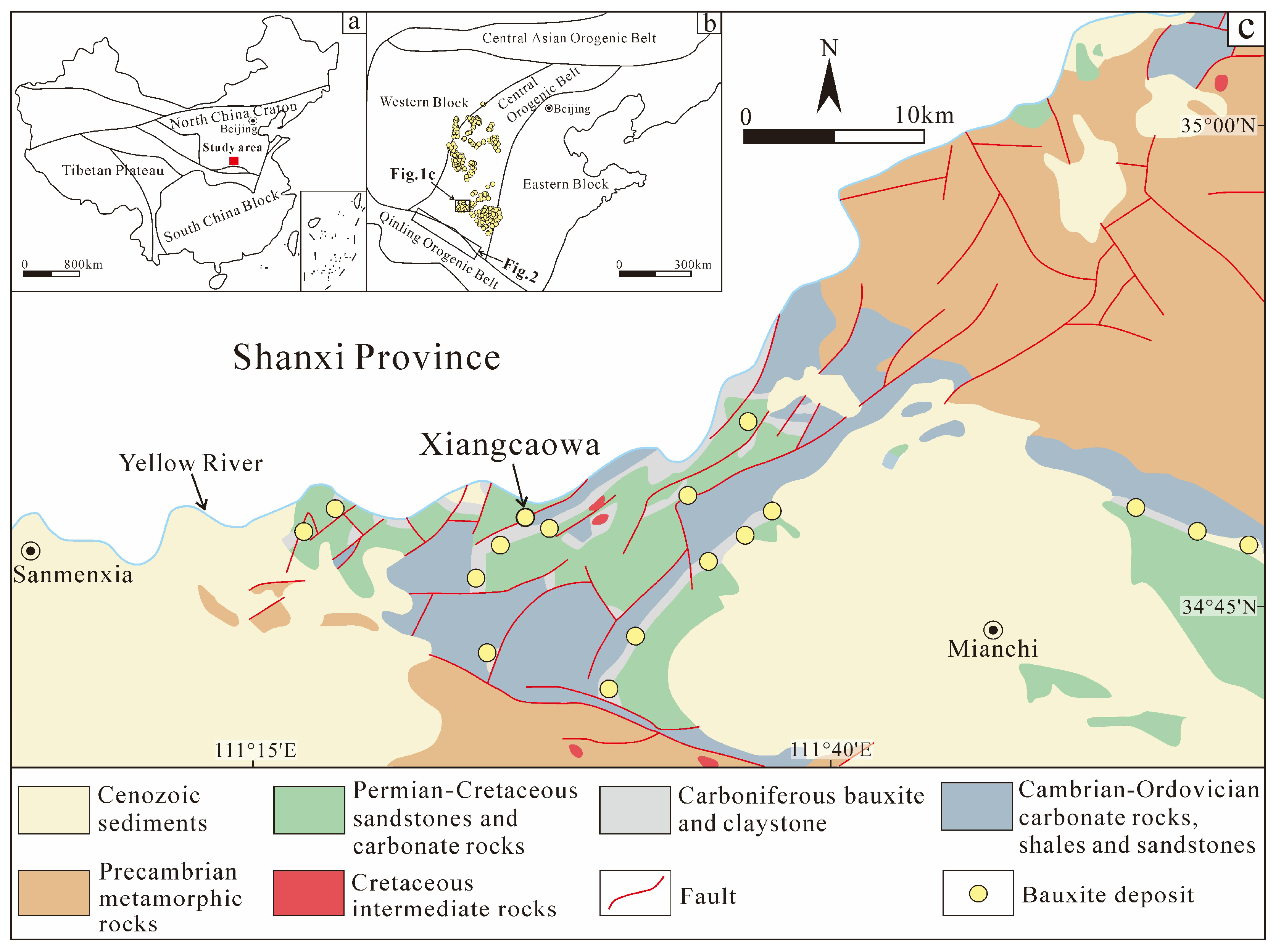
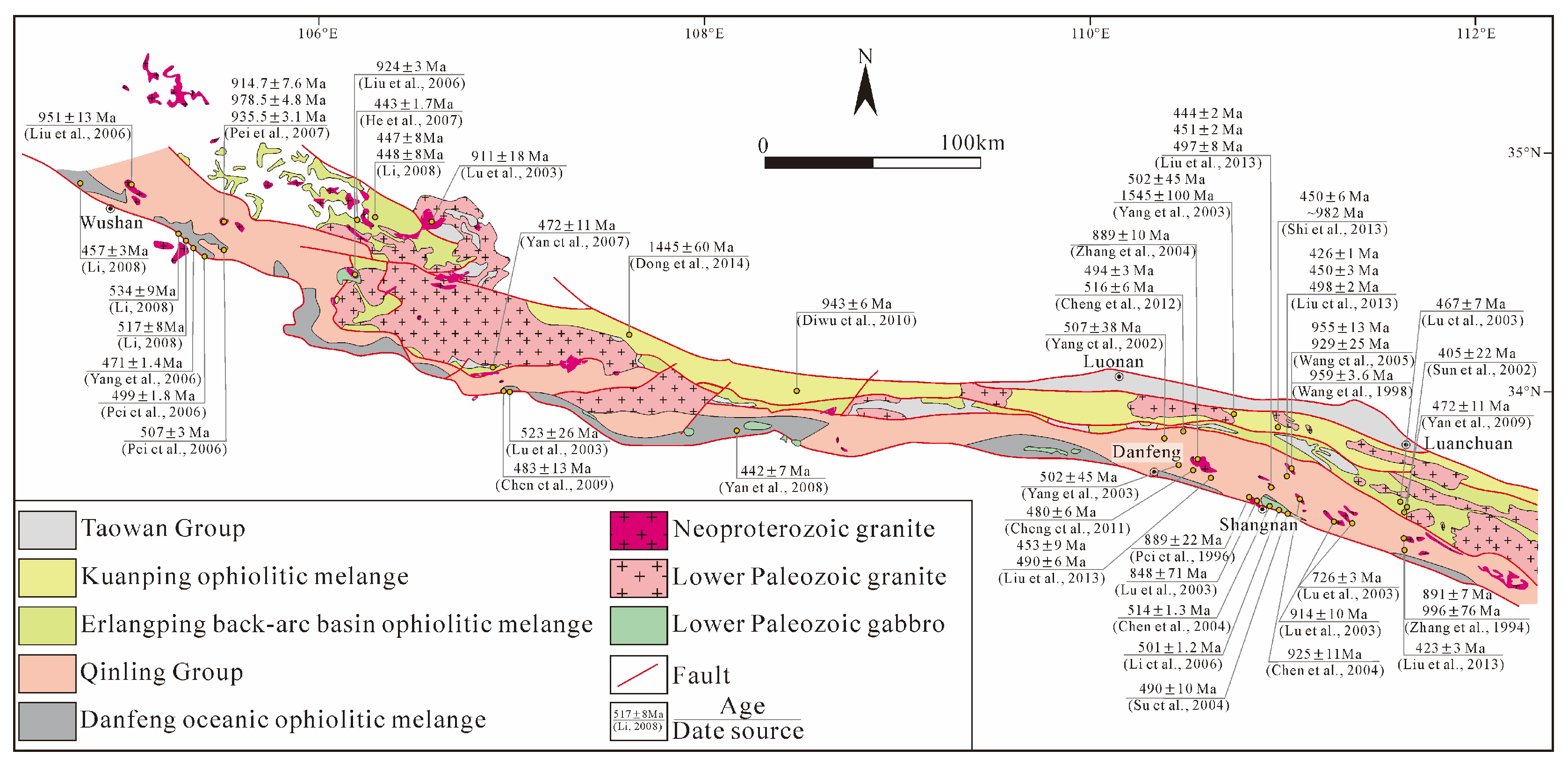
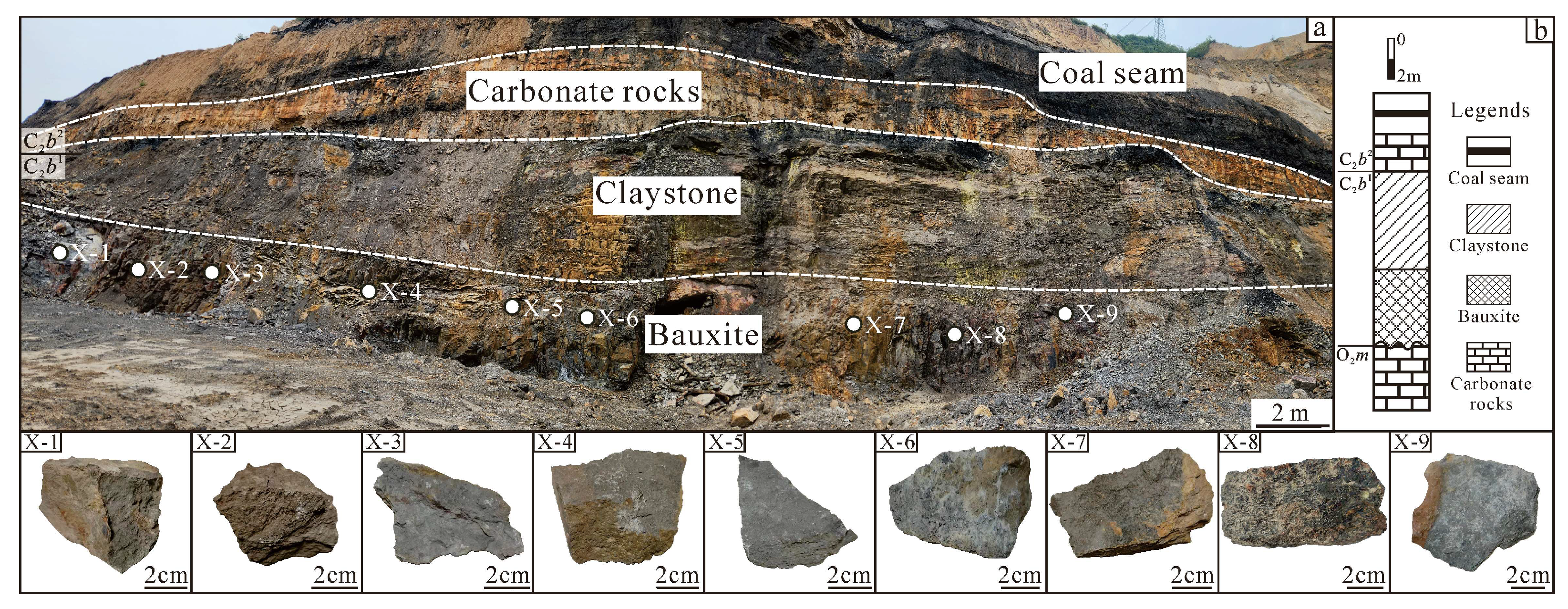
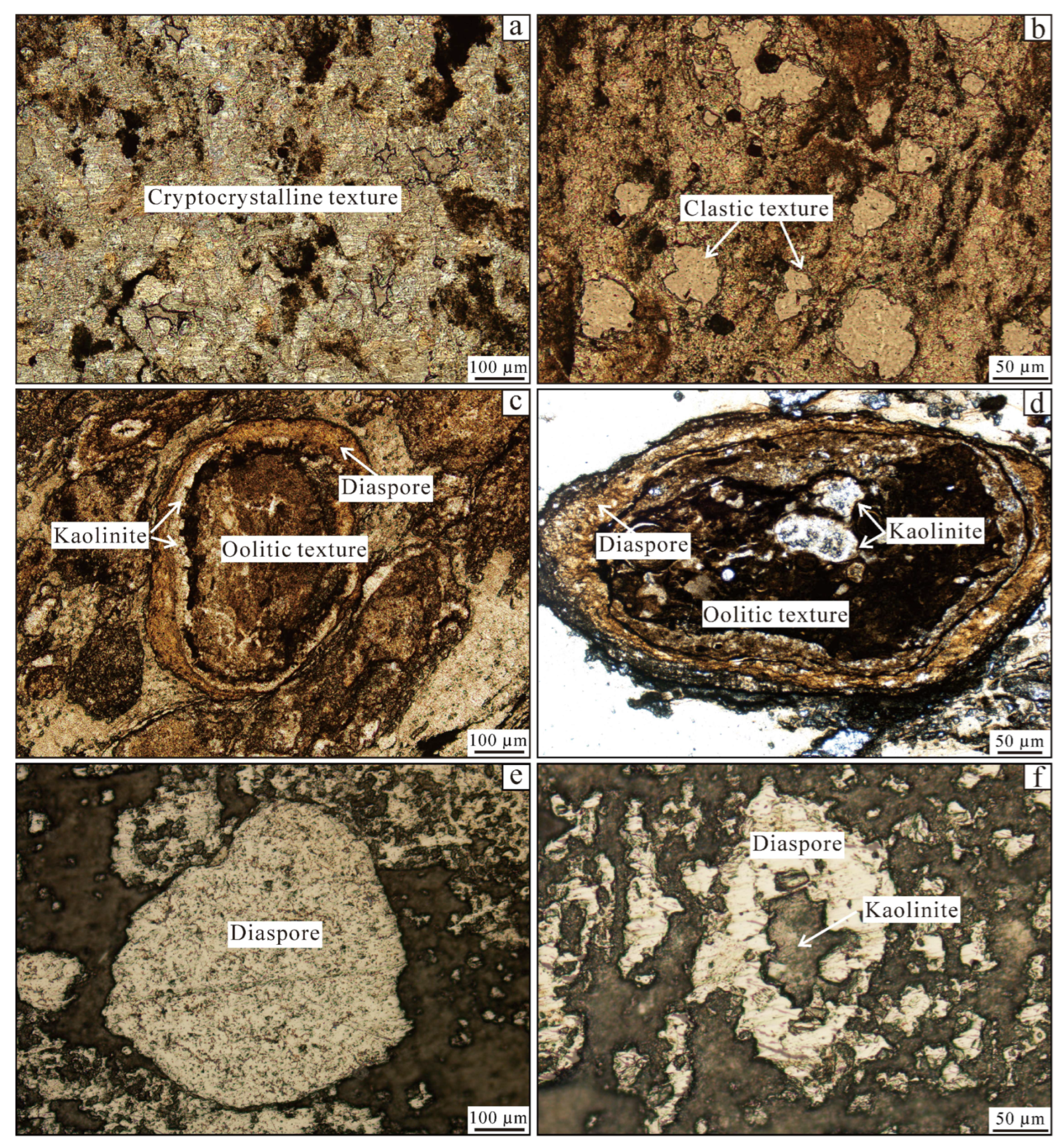

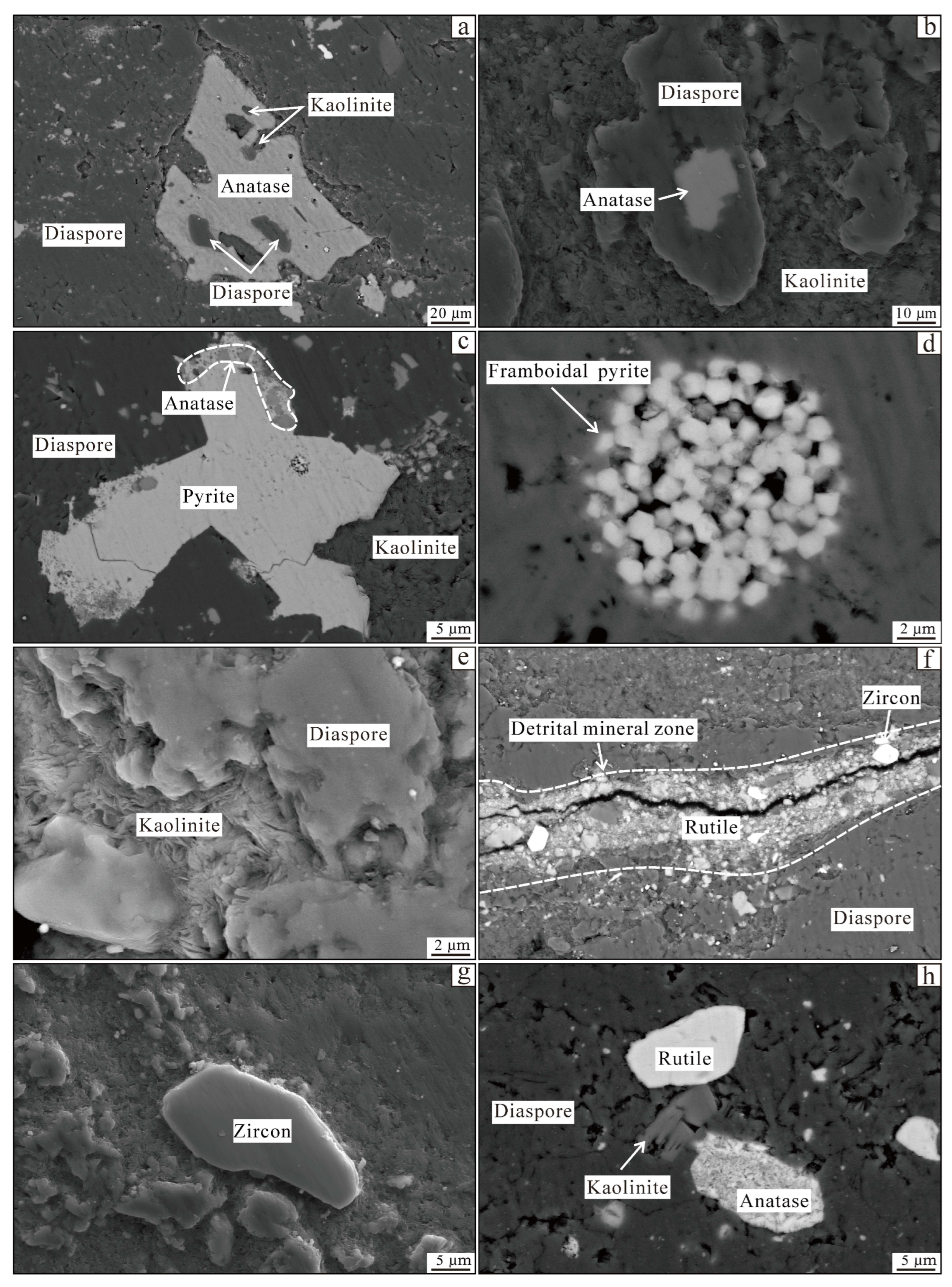
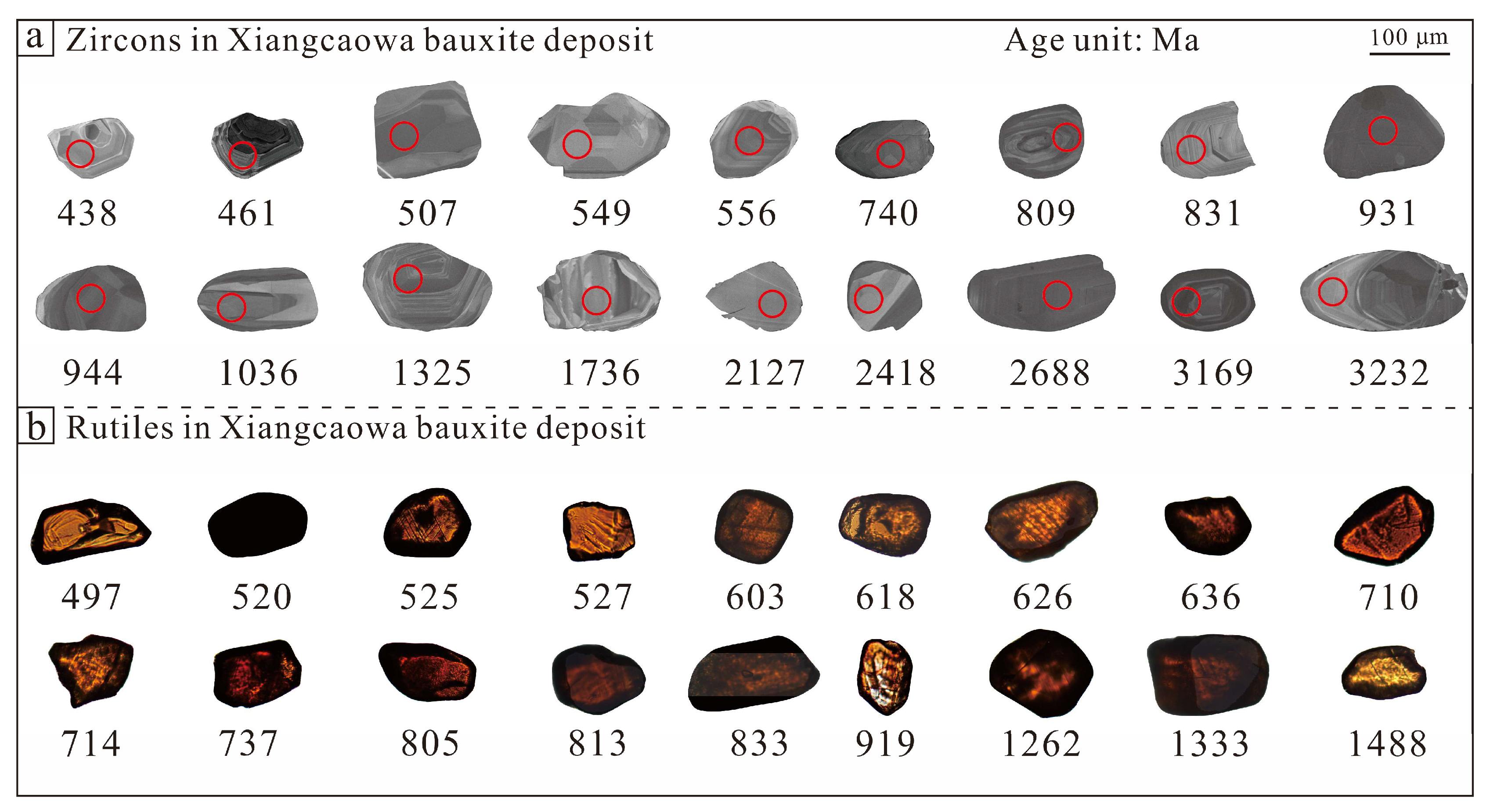
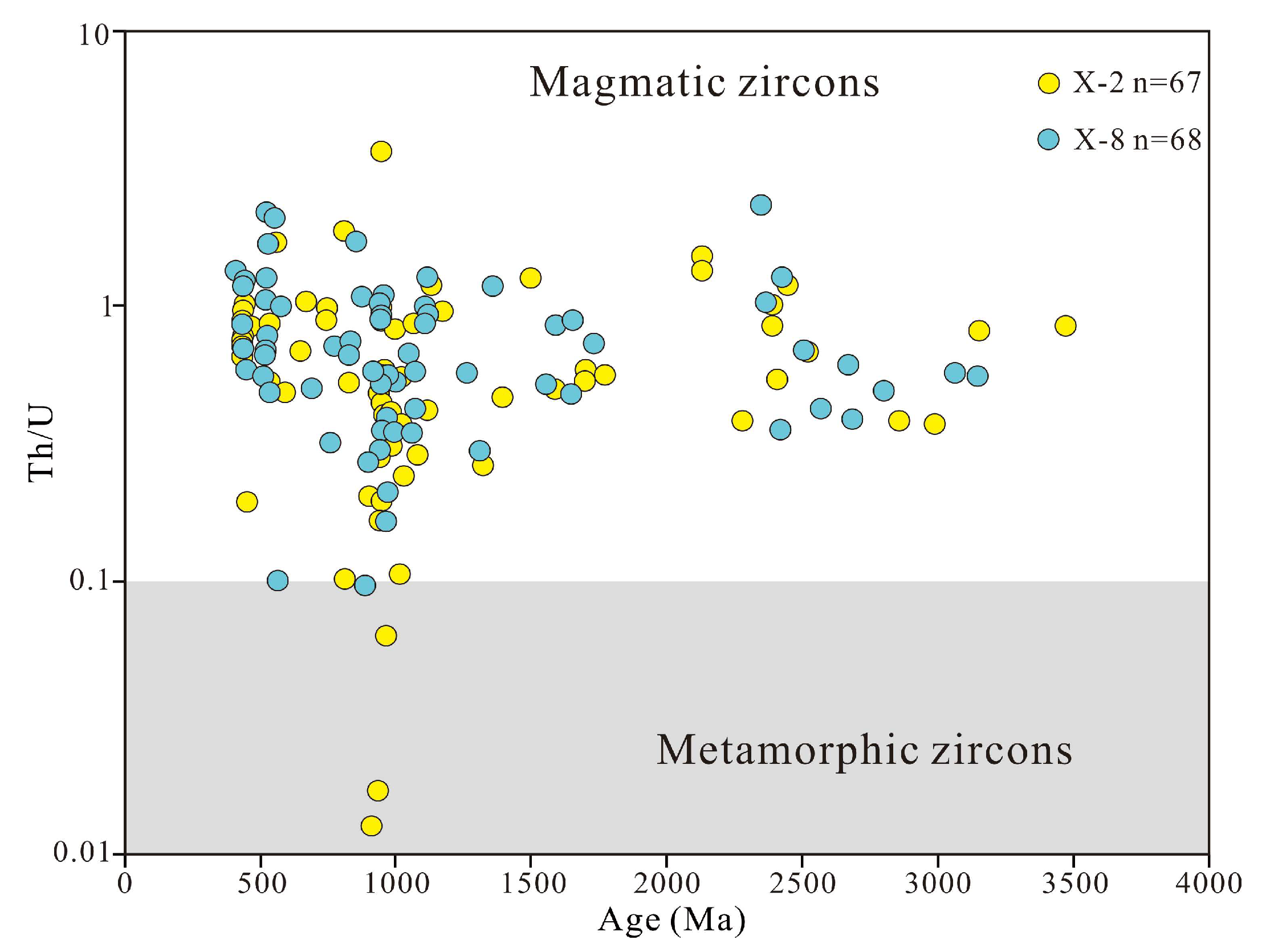


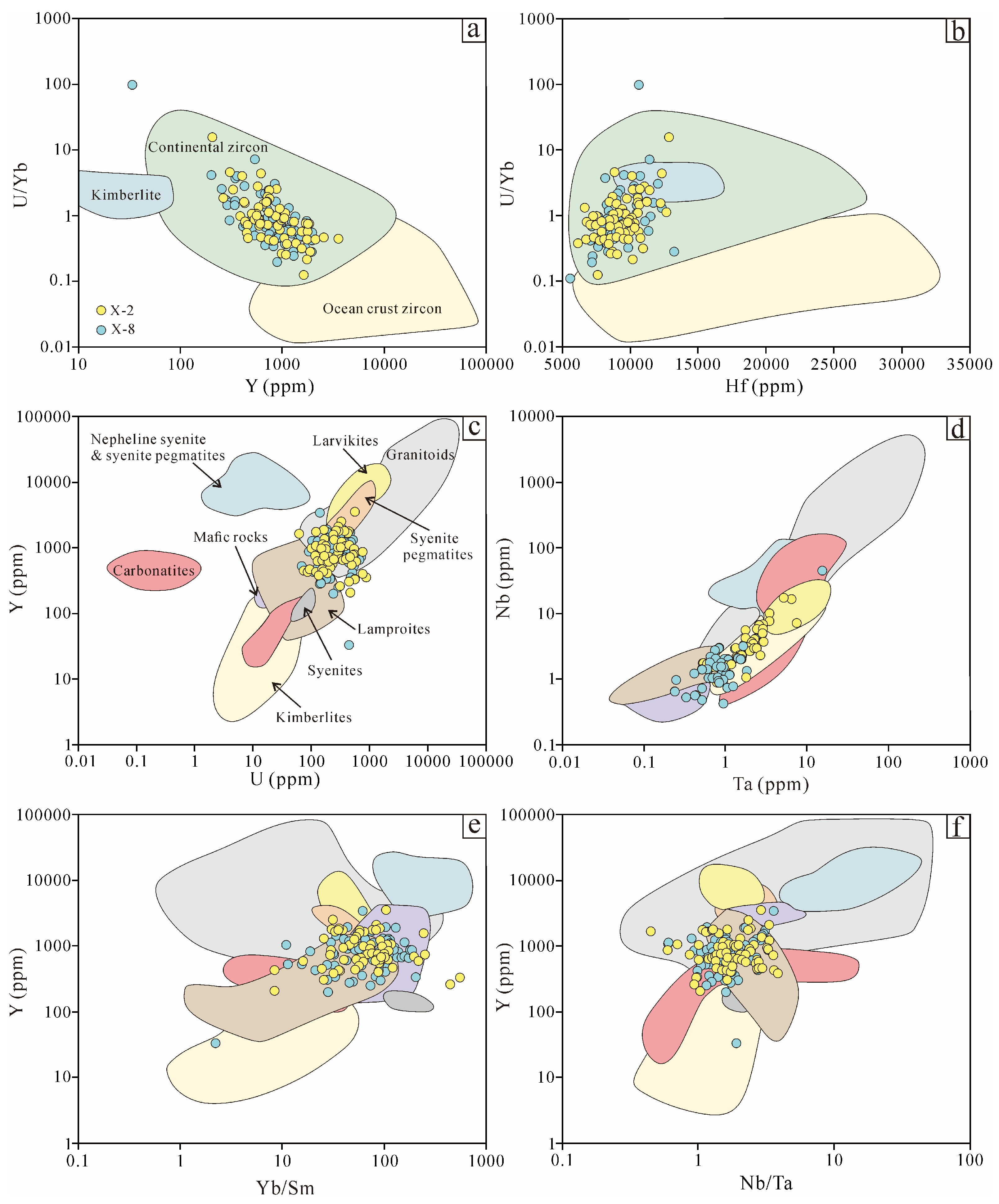
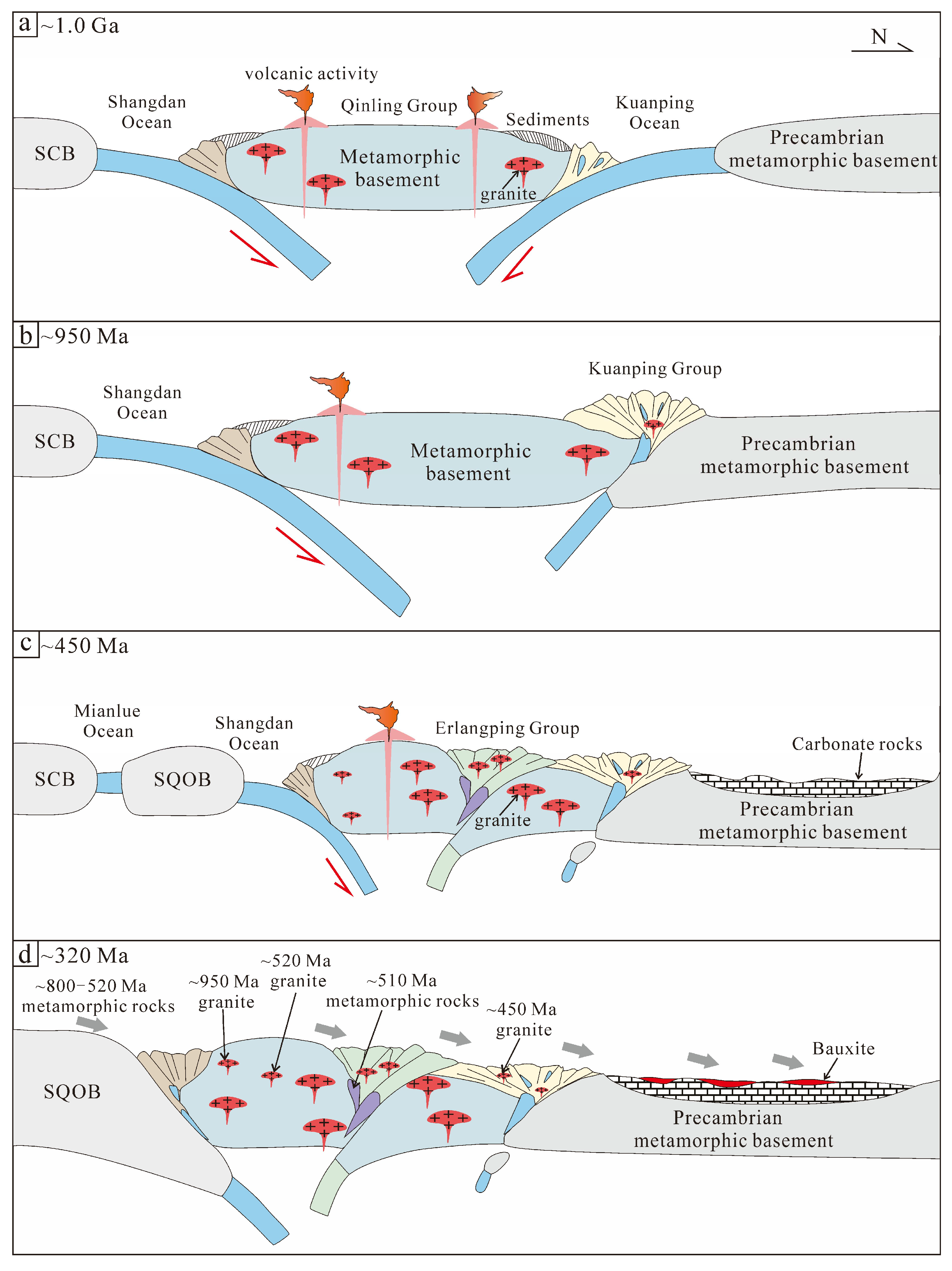
Disclaimer/Publisher’s Note: The statements, opinions and data contained in all publications are solely those of the individual author(s) and contributor(s) and not of MDPI and/or the editor(s). MDPI and/or the editor(s) disclaim responsibility for any injury to people or property resulting from any ideas, methods, instructions or products referred to in the content. |
© 2025 by the authors. Licensee MDPI, Basel, Switzerland. This article is an open access article distributed under the terms and conditions of the Creative Commons Attribution (CC BY) license (https://creativecommons.org/licenses/by/4.0/).
Share and Cite
Wang, W.; Sun, X.; Liu, L.; Zhao, L.; Liang, R.; Zhang, T.; Liu, X. Metallogenic Process of Forming the Large Xiangcaowa Karstic Bauxite Deposit from the Southern Margin of the North China Craton. Minerals 2025, 15, 310. https://doi.org/10.3390/min15030310
Wang W, Sun X, Liu L, Zhao L, Liang R, Zhang T, Liu X. Metallogenic Process of Forming the Large Xiangcaowa Karstic Bauxite Deposit from the Southern Margin of the North China Craton. Minerals. 2025; 15(3):310. https://doi.org/10.3390/min15030310
Chicago/Turabian StyleWang, Wenxia, Xuefei Sun, Lei Liu, Lihua Zhao, Rongrong Liang, Tongyi Zhang, and Xuefei Liu. 2025. "Metallogenic Process of Forming the Large Xiangcaowa Karstic Bauxite Deposit from the Southern Margin of the North China Craton" Minerals 15, no. 3: 310. https://doi.org/10.3390/min15030310
APA StyleWang, W., Sun, X., Liu, L., Zhao, L., Liang, R., Zhang, T., & Liu, X. (2025). Metallogenic Process of Forming the Large Xiangcaowa Karstic Bauxite Deposit from the Southern Margin of the North China Craton. Minerals, 15(3), 310. https://doi.org/10.3390/min15030310




